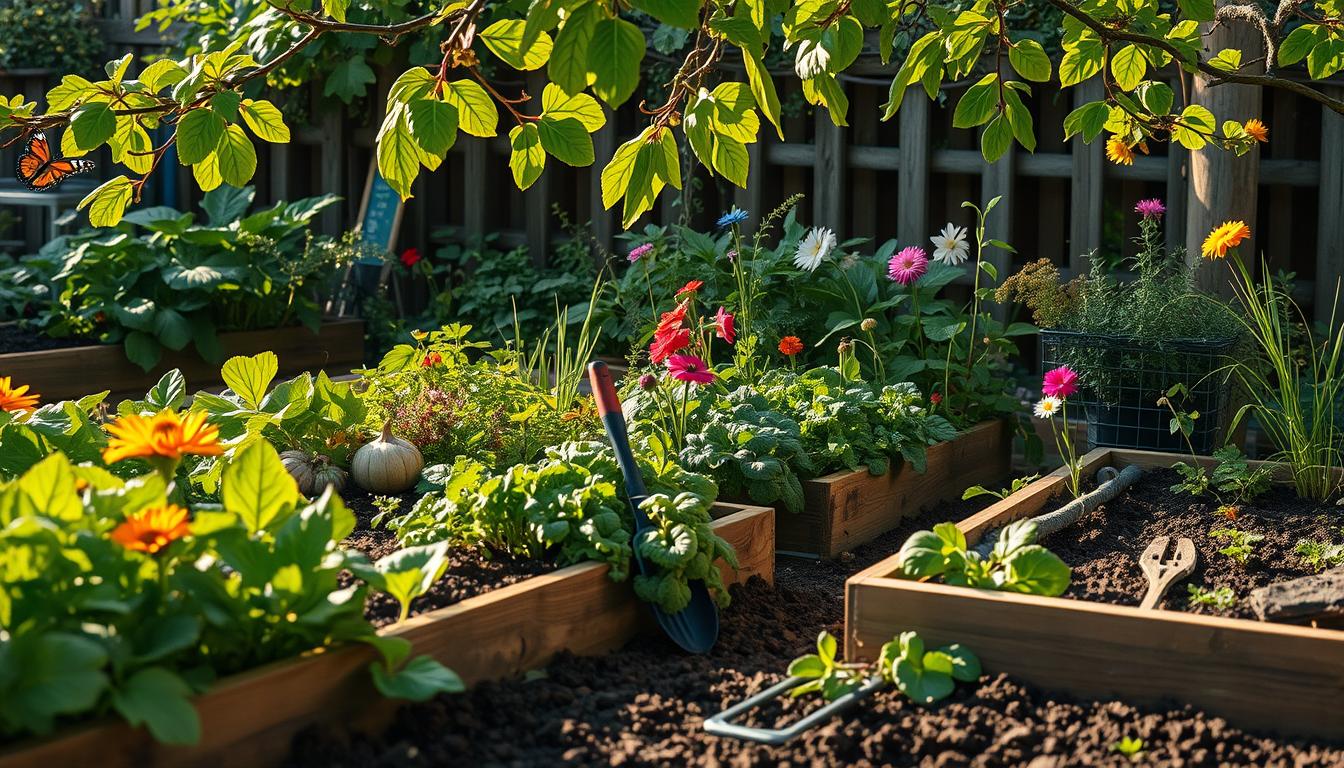I’m excited to share my knowledge and experience with you on Organic Gardening. It’s a natural and sustainable way to grow your own food. We’ll cover the basics of creating a lush, chemical-free garden through sustainable gardening practices.
Whether you’re new to gardening or have lots of experience, you’ll find helpful tips here. We’ll focus on creating a thriving Organic Garden. You’ll learn how to use natural gardening methods that are good for you and the environment. Sustainable gardening is more than just a hobby; it’s a way of life.
What is Organic Gardening?
Exploring gardening, I’ve learned the value of using natural methods. Organic gardening keeps soil healthy, controls pests, and helps plants grow. It’s good for the planet and makes growing food healthier and more sustainable.
Organic gardening lets me create a balanced garden ecosystem. This supports my plants, soil, and the environment. Important tips include using compost, rotating crops, and planting companions to keep soil fertile and pests away.
Overview of Organic Practices
Organic gardening uses many practices to make a garden thrive. Some include:
- Using natural fertilizers and pest control methods
- Conserving water with efficient systems
- Creating a diverse and balanced ecosystem
Benefits of Going Organic
Organic gardening offers many benefits. These include:
- Healthier and more nutritious food
- A smaller environmental impact
- A sustainable and cost-effective gardening method
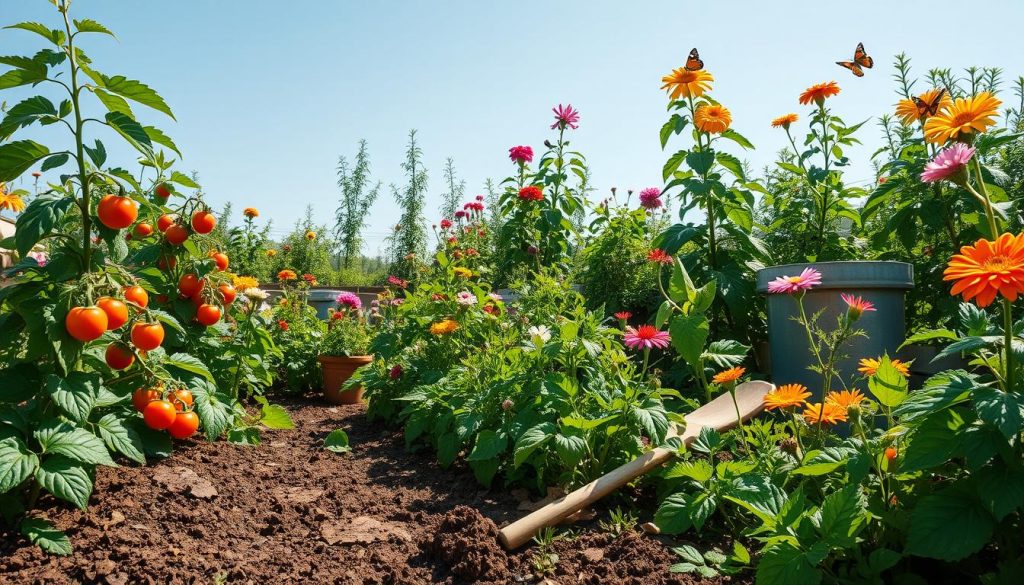
Getting Started with My Organic Garden
To start my organic garden, I need to pick the right spot. I’ll look at sunlight, soil quality, and how easy it is to get to. This ensures my garden gets the best conditions.
Knowing my soil’s quality is key for a great garden. I’ll test it to see its pH level and nutrient content. This helps me improve it and make a good base for my plants.
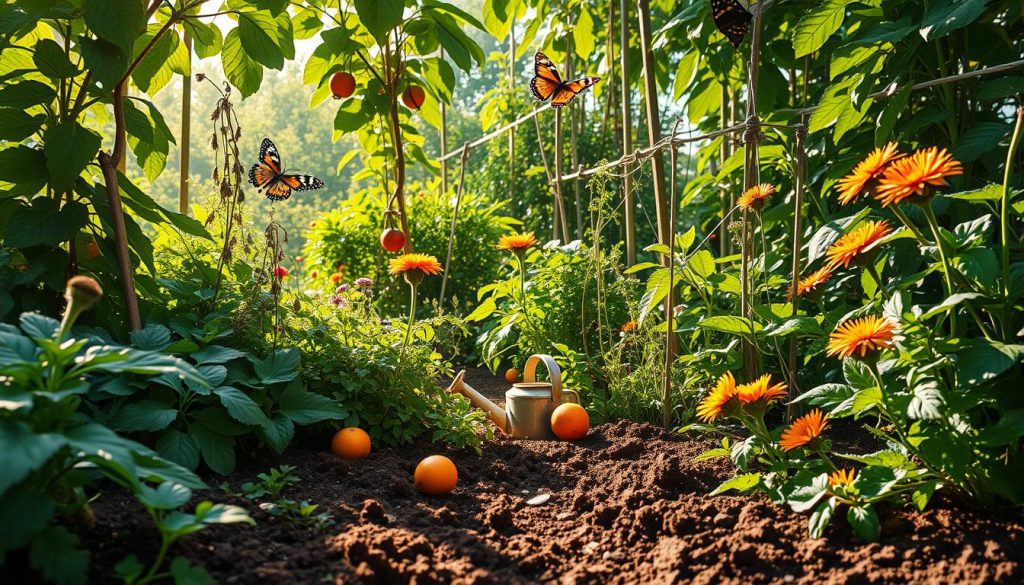
Choosing the Right Location
When picking a spot, sunlight is important. Most plants need at least six hours of direct sunlight a day. I also want my garden to be easy to get to and maintain.
Understanding Soil Quality
Soil quality is vital for a healthy garden. I’ll test it often to keep it balanced and fertile. This way, I can enjoy the benefits of organic gardening.
Selecting the Best Organic Seeds
Choosing the right seeds is key for a good harvest in organic gardening. I think about using organic resources and natural gardening methods. Deciding between heirloom and hybrid seeds is a big choice for me.
Heirloom vs. Hybrid Seeds
Heirloom seeds can be saved and replanted because they’re open-pollinated. Hybrid seeds, on the other hand, are bred for certain traits and can’t be saved. I like heirloom seeds for their unique qualities and how well they adapt to my area.
Sources for Organic Seeds
I look for companies that focus on natural gardening and offer non-GMO seeds. Seed Savers Exchange and High Mowing Seeds are good choices. I also buy from local nurseries or gardening stores that support organic gardening.
By picking the right seeds and using organic gardening resources, I can grow a healthy and sustainable garden. This garden benefits me and the environment. 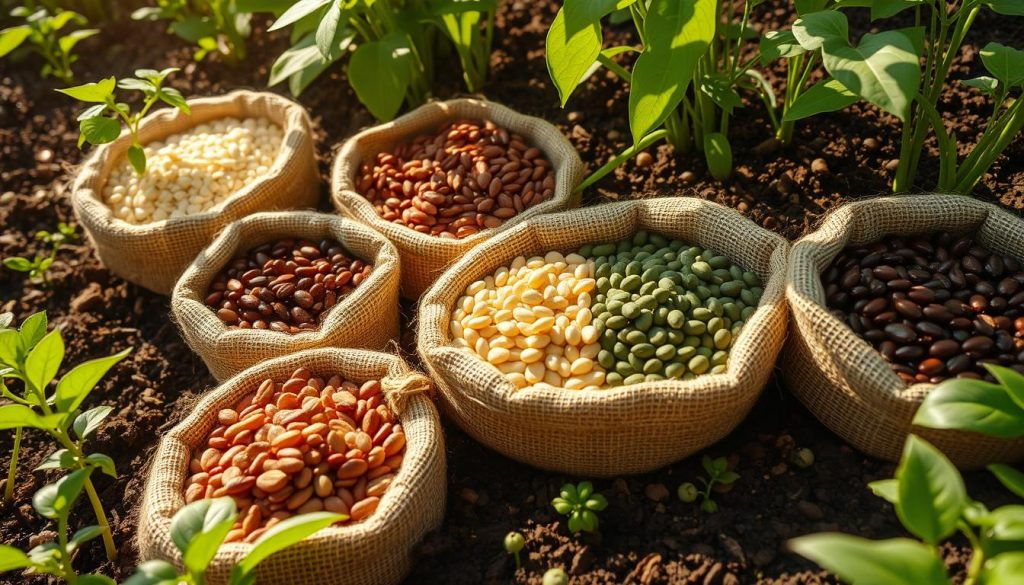
Essential Tools for Organic Gardening
As I tend to my organic garden, I’ve learned the value of the right tools. Practices like composting and mulching are key for a healthy garden. Here, I’ll share the essential tools for eco-friendly gardening and how to use them well.
Must-Have Gardening Tools
Key tools for organic gardening include a garden fork, hoe, and watering can. They help with soil prep, weeding, and watering. Also, a compost bin and mulch are crucial for a sustainable garden.
Sustainable Gardening Practices
To garden eco-friendly, try these tips:
- Composting: Turn food scraps and yard waste into nutrient-rich soil
- Mulching: Retain moisture and suppress weeds with organic mulch
- Conserving water: Use efficient irrigation systems and collect rainwater
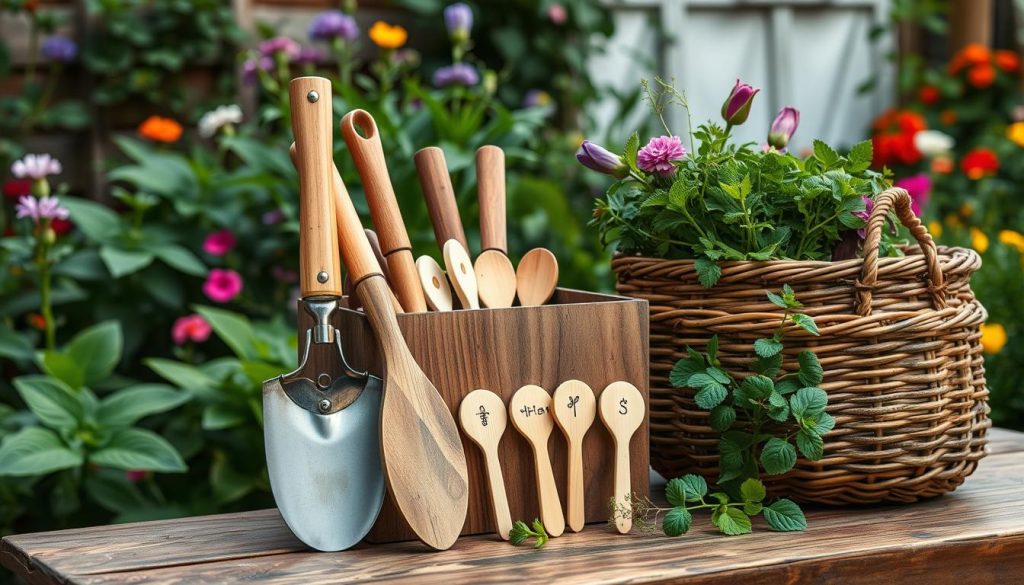
Using these tools and practices has greatly improved my garden. Sustainable gardening is good for the planet and makes my garden healthier and more productive.
Soil Preparation for Organic Gardening
As I work on my organic garden, I’ve learned how crucial soil preparation is. It’s the base for my plants to grow well. I make sure my soil is chemical-free, creating a safe space for my plants.
Testing the soil pH is a key step. It shows if my soil is too acidic or too alkaline. This info helps me pick the right plants and organic amendments for my soil.
I use compost, manure, and peat moss to improve my soil. These help with drainage, aeration, and water retention. This way, my garden becomes a balanced and thriving ecosystem.
Testing Soil pH
Testing soil pH is easy. I can send a sample to a lab or use a DIY kit. The results tell me my soil’s pH level, which can be acidic or alkaline.
Based on the results, I can adjust my soil’s pH. I add lime or sulfur to do this.
Adding Organic Amendments
Adding organic amendments is vital for soil health. They improve drainage, water retention, and nutrient balance. This way, my garden stays healthy and free from toxins.
Crop Rotation and Companion Planting
As I grow my organic garden, I’ve learned about crop rotation and companion planting. These methods keep my garden healthy and diverse. I’m excited to share this knowledge with you. By using organic garden tips and natural gardening, you can grow a thriving garden without harsh chemicals.
Benefits of Crop Rotation
Crop rotation has many benefits. It improves soil health, boosts crop yields, and fights pests and diseases. It also prevents soil nutrient loss. Here are some key benefits:
- Improved soil structure and fertility
- Increased crop yields and better fruit quality
- Reduced soil erosion and nutrient depletion
- Enhanced biodiversity and ecosystem services
Top Companion Plants for My Garden
Companion planting is crucial for a balanced garden. It helps plants grow better, fights pests, and improves soil health. Some top companion plants are:
- Marigolds, which repel nematodes and attract beneficial insects
- Basil, which enhances the flavor and texture of nearby plants
- Beans, which provide shade and support for other plants
By using these organic garden tips and natural gardening methods, you can create a vibrant and diverse garden. Always rotate your crops and choose companion plants wisely. Happy gardening!
Managing Pests Naturally
As I care for my organic garden, I’ve learned that controlling pests is key. Organic gardening resources help me spot common pests and use natural methods to fight them. Sustainable gardening keeps my garden balanced, helping plants grow strong.
Knowing your garden’s pests is the first step. Aphids, whiteflies, and spider mites are common enemies. Organic gardening guides teach how to spot and stop these pests. Here are some natural ways to keep them away:
- Neem oil: a natural insecticide that can be used to control a wide range of pests
- Diatomaceous earth: a powder made from fossilized algae that can be used to dehydrate and kill pests
- Companion planting: planting certain plants together to deter pests, such as marigolds and nasturtiums
Using these organic methods, your garden will be healthy and balanced. This way, you can grow plants without using harmful chemicals. Always watch your garden for pests and act fast if you see any.
With the right organic gardening tools and practices, your garden can thrive. Enjoy your gardening journey!
| Pest | Organic Control Method |
|---|---|
| Aphids | Neem oil, soap solution |
| Whiteflies | Yellow sticky traps, diatomaceous earth |
| Spider mites | Neem oil, increase humidity |
Watering Techniques for Organic Gardens
As I care for my organic garden, I’ve learned how crucial proper watering is. Using methods like drip irrigation and mulching saves water and helps plants grow well. These practices also make the produce better for you and the planet.
For the best results, knowing how to water is key. Water plants deeply but not too often to help their roots grow strong. Also, avoid watering from above to stop diseases.
Best Practices for Watering
- Water plants in the early morning or evening to reduce evaporation
- Use a drip irrigation system to deliver water directly to the roots
- Mulch around plants to retain moisture and suppress weeds
Drip Irrigation vs. Traditional Methods
Drip irrigation beats traditional watering in many ways. It saves water, cuts down on soil erosion, and boosts plant health. By using drip irrigation in my garden, I help the environment and enjoy better produce.
Fertilizing My Organic Garden
I’ve learned how crucial fertilizing is for my organic garden’s health. Organic gardening techniques help my plants grow strong. It’s all about using natural fertilizers without synthetic chemicals.
There are many organic fertilizers like compost, manure, and green sand. They give my plants the nutrients they need. They also make the soil better and healthier. Plus, I can make my own fertilizers from kitchen scraps and yard waste. This saves money and reduces waste.
- Improved soil fertility and structure
- Increased crop yields and plant growth
- Reduced environmental pollution and waste
- Cost-effective and sustainable
By using organic gardening, my garden becomes a balanced ecosystem. It’s good for my plants and the environment. Whether I buy organic fertilizers or make my own, my garden will grow well and give me healthy food.
| Organic Fertilizer | Benefits |
|---|---|
| Compost | Improves soil fertility and structure |
| Manure | Provides essential nutrients for plant growth |
| Green Sand | Helps to improve soil drainage and aeration |
Seasonal Gardening Tips
As I tend to my organic garden, I’ve learned the value of seasonal gardening. With the right tools, my garden flourishes all year. Sustainable gardening means working with nature’s rhythms.
In spring and fall, I plant crops like leafy greens and carrots. Organic resources like compost help them grow well. For example, compost and manure make my soil rich and healthy.
Planting in Spring and Fall
- Choose crops that are suitable for the season
- Prepare the soil with organic amendments
- Plant at the right time to avoid extreme temperatures
In winter, I protect my garden with mulch and covers. This keeps moisture in and soil warm. Organic gardening and sustainable practices keep my garden productive all year.
Winter Garden Care Strategies
| Month | Gardening Task |
|---|---|
| December | Apply mulch to retain moisture |
| January | Prune fruit trees and shrubs |
| February | Start seedlings indoors for spring planting |
By following these tips and using organic resources, I create a thriving garden. It brings me joy and fresh produce all year.
Harvesting and Storing My Produce
As your organic garden grows, it’s time to enjoy the fruits of your labor. Knowing when to pick your crops and how to store them is key. This ensures your produce stays fresh and eco-friendly.
When to Harvest
Timing is everything when picking your organic fruits and veggies. Watch for signs like size, color, and firmness. Regular checks will help you pick at the best time, when they taste and are most nutritious.
Storing Your Organic Produce
After harvesting, focus on storing your produce right. The right storage can make your food last longer. Keep delicate items like greens and berries in the fridge. Store harder items in a cool, dark spot.
Try methods like canning, freezing, or dehydrating to enjoy your organic gardening all year.

